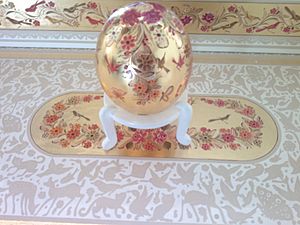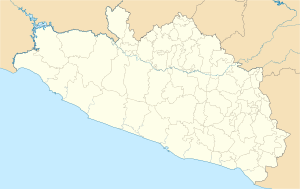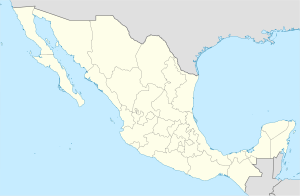Olinalá facts for kids
Quick facts for kids
Olinalá
|
|
|---|---|
|
Municipal seat and city
|
|
| Country | |
| State | Guerrero |
| Municipality | Olinalá |
| Time zone | UTC-6 (Zona Centro) |
Olinalá is a city in the Mexican state of Guerrero. It is also the main town of the Olinalá municipality. The city is famous all over Mexico for its beautiful handmade crafts, especially its special lacquered items called Lacas de Olinalá.
Contents
Olinalá: Home of Amazing Lacquer Art

Olinalá is known as the most important place in Mexico for making lacquer art. Lacquer is a special type of finish that gives objects a shiny, protective coating.
A Long History of Craftsmanship
The art of lacquer making came to Mexico from Asia. It traveled on Spanish trading ships called "Manila Galleons" or Nao de la China. In Olinalá, families have passed down these special art techniques for many generations.
Artists in Olinalá create many different products. These include everyday items like trays and chests. They also make decorative pieces, such as the famous "cajitas de Olinalá" (small lacquered boxes).
How the Art is Made: The Steps
Making Olinalá lacquer art is a long process, taking about 29 steps! Here's a simplified look at how these beautiful pieces are made:
- Preparing the Wood: First, the wood is rubbed with special oils from plants or insects.
- Applying the Base: A thick paste is then put on the wood. This paste is made from minerals called tecoztle in the Nahuatl language. It feels like sand and is yellowish. It's mixed with oils from chia seeds or flaxseed.
- Smoothing the Surface: This paste forms the base. Next, another mixture called tesicalte is ground into a very fine powder using a stone tool called a tlalmetate.
- Adding Color: The tesicalte powder is mixed with the color that will be the background of the artwork. This mixture is then spread onto the wood using a brush made from a deer's tail.
- Polishing and Drying: The wood is polished until most of the tesicalte disappears. Then, the main background color is added. The piece is left to dry for a few days.
- Final Lacquer: Finally, a special lacquer is applied. This protects the surface and makes it shiny. It also gets the piece ready for more decoration. The final step is adding a varnish made with linseed oil.
Beautiful Designs and Meanings
The artists use different ways to decorate their work:
- Golden Designs: Fine paintbrushes made of cat hair are used to create golden patterns on the lacquered wood.
- Scratched Designs: Techniques like "rayado vaciado" use two layers of lacquer. The top layer is carefully scratched away to show the color underneath. "Rayado punteado" uses dots to create patterns.
- Bright Colors: Traditional decorations often use very bright and lively colors.
The designs often show things from nature. You might see flowers, leaves, landscapes, or animals. Rabbits are very popular, along with foxes, jaguars, cats, and deer. The rabbit is especially important because of its meaning in Aztec mythology. Each finished piece is unique and full of vibrant colors. They are made on carved wood or on gourds (a type of squash).
All the materials used in Olinalá, like the special minerals and oils, come from the Guerrero region itself. Olinalá is located high up, about 1,600 meters (5,250 feet) above sea level.
Protecting Olinalá's Special Art
The Mexican government wanted to protect the country's special crafts and help the artists. In 1991, they created a law to promote and protect "Industrial Property". This helps prevent others from unfairly copying unique products.
In 1993, the artists of Olinalá asked for something called an "Appellation of Origin" for their lacquer art. This means that only lacquer art made in Olinalá, using its traditional methods and materials, can be called "Lacas de Olinalá." It's like a special stamp of approval that protects their unique craft. The Instituto Mexicano de la Propiedad Industrial (IMPI) approved this in 1995.
See also
 In Spanish: Olinalá (Guerrero) para niños
In Spanish: Olinalá (Guerrero) para niños



